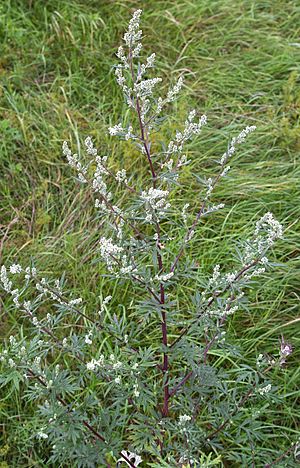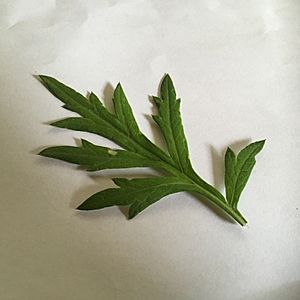Common mugwort facts for kids
Quick facts for kids Common mugwort |
|
|---|---|
 |
|
| Scientific classification | |
| Genus: |
Artemisia
|
| Species: |
vulgaris
|
Common mugwort (scientific name: Artemisia vulgaris) is a type of flowering plant. It belongs to the daisy family, called Asteraceae. You might know it simply as mugwort, as it's the most common plant with this name.
People sometimes call mugwort by other names too. These include riverside wormwood, felon herb, chrysanthemum weed, wild wormwood, old Uncle Henry, sailor's tobacco, naughty man, old man, or St. John's plant. Just be careful not to confuse it with St John's wort! For a long time, mugworts have been used in medicine and as cooking herbs.
Where Mugwort Grows
Mugwort is originally from temperate parts of Europe, Asia, North Africa, and Alaska. It has also spread and now grows naturally in North America. Some people there even see it as an invasive weed because it grows so easily.
You can often find mugwort in places with rich soil, especially where the ground has been disturbed. This includes waste areas, along roadsides, and in other wild or uncultivated spots.
How People Use Mugwort
For a long time, mugwort was used to flavor and add a bitter taste to "gruit ales." These were types of fermented grain drinks that didn't use hops.
In Vietnam, mugwort is a popular herb used in cooking to add a nice smell and flavor to dishes.
In China, the young, crunchy stems of mugwort are a seasonal vegetable. They are called luhao (Chinese: 芦蒿; pinyin: lúhāo). People often use them in stir-fried meals.
In Nepal, mugwort is known as titepati. The word tite means bitter, and pati means leaf. People in Nepal use this plant in many ways. They offer it to their gods, use it to clean their homes (by sweeping floors or hanging bundles outside), and burn it as incense. It's also used as a medicinal plant.
What Mugwort Looks Like
Mugwort is a tall plant that grows back every year. It can reach about 1 to 2 meters (3 to 6.5 feet) tall, and sometimes even taller, up to 2.5 meters (8 feet). It has a wide system of underground stems called rhizomes. These rhizomes help the plant spread easily, even more than its seeds do. If pieces of the rhizome are moved, new plants can grow from them.
The leaves are usually 5 to 20 centimeters (2 to 8 inches) long. They are dark green and divided into many smaller parts. The underside of the leaves is covered with thick, white, fuzzy hairs. The stems stand straight up and often have a reddish-purple color. They also have grooves along them.
The Ukrainian name for Mugwort is Чørnobyl, which means "Black Stalk." The city of Chernobyl in Ukraine actually gets its name from this plant!
Mugwort flowers are quite small, about 5 millimeters (0.2 inches) long. They have many yellow or dark red petals and are shaped like a star. The flowers grow in narrow, many-branched clusters. Mugwort usually blooms from the middle of summer to early autumn.
Many types of Lepidoptera (which are butterflies and moths) like to eat the leaves and flowers of the mugwort plant. One example is the Ostrinia scapulalis moth.
See also
 In Spanish: Artemisa (planta) para niños
In Spanish: Artemisa (planta) para niños



